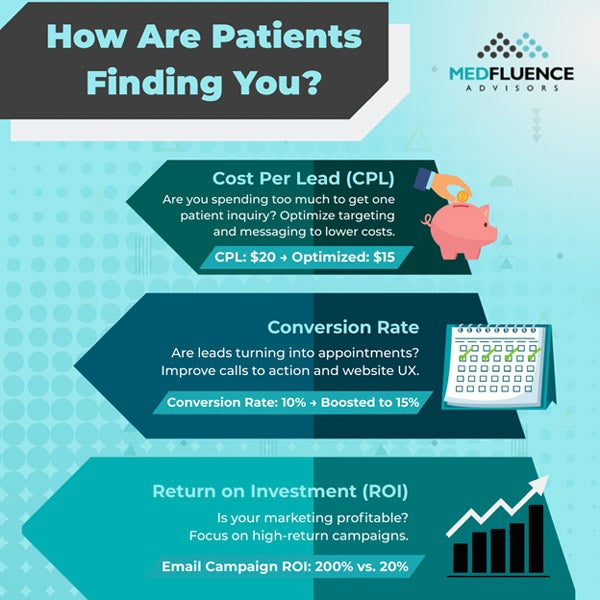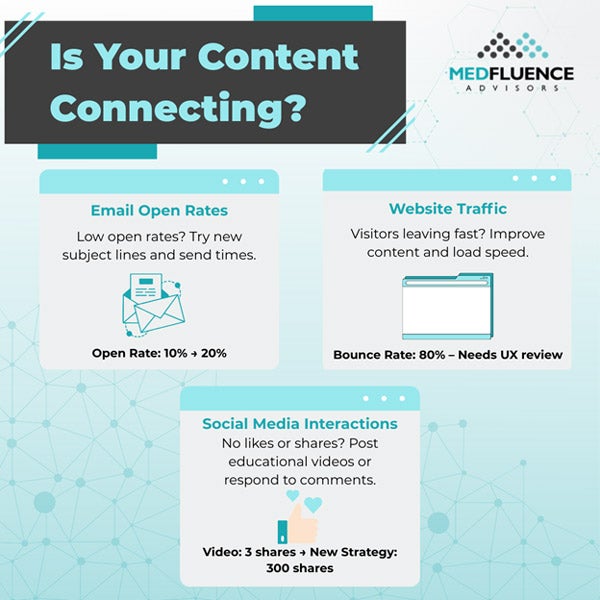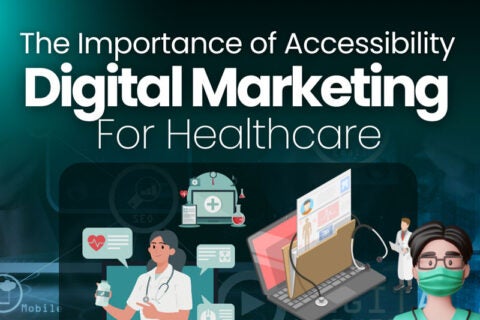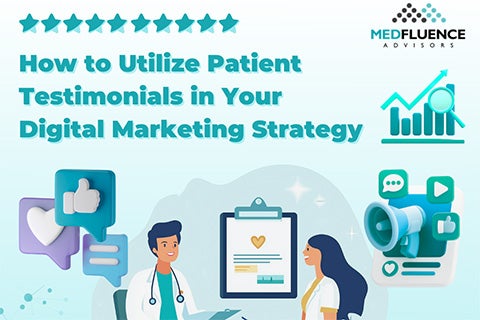Data-Driven Marketing: How to Use Analytics to Improve Your Campaigns
In the quiet examination room of a small medical practice, life-changing treatments happen every day. Yet for too many physicians, their ability to help patients is limited not by their medical skill, but by something far more fundamental: patients simply don’t know they exist. Behind this disconnect lies a missed opportunity that affects both sides of the healthcare equation – suffering patients continue searching for answers while physicians with innovative solutions struggle to reach them.
The numbers tell a compelling story. Today’s patients leave digital footprints throughout their healthcare journey – from search queries about mysterious symptoms to engagement with medical content and virtual consultations. These signals represent real people seeking relief, yet most private practices lack the tools to interpret this data and turn it into meaningful patient connections.
What Is Data-Driven Marketing?
Data-driven marketing uses analytics to guide decision-making rather than relying on gut instincts or guesswork. It involves collecting and analyzing information about patient behavior, campaign performance, and market trends to create more effective outreach strategies.
For years, many healthcare practices relied on intuition or traditional advertising methods to attract patients. While this approach can work to some extent, it often wastes resources on broad, unfocused messaging. Data-driven marketing, on the other hand, helps practices refine their efforts by showing what works and what doesn’t.
By using real numbers instead of assumptions, practices can:
- Identify the most effective marketing channels.
- Target patients who are more likely to book an appointment.
- Improve messaging based on patient interests and concerns.
- Adjust campaigns quickly when something isn’t working.
The result? Less wasted ad spend, stronger patient connections, and a better return on investment.
Key Analytics Metrics to Track
Tracking the right metrics helps healthcare practices measure success and make informed decisions. Without data, marketing efforts are just guesswork. The right numbers provide a clear picture of what’s working, what needs improvement, and where to invest resources. Here are three main categories of analytics metrics to focus on.
1. Patient Acquisition Metrics
These numbers show how well marketing efforts attract new patients. Bringing in potential patients is the first step in growing a practice, but not all leads are equal. The following metrics help measure the quality and efficiency of patient acquisition strategies.
Cost Per Lead (CPL)
This measures the amount spent on marketing to generate one new patient inquiry. It includes expenses related to digital advertising, content creation, social media promotions, and any other marketing channels used.
- Why It Matters: A high CPL means a practice is spending too much to acquire leads, which can quickly drain the budget. The goal is to lower CPL while maintaining or increasing lead quality.
- How to Improve It: Optimizing ad targeting, improving website conversion rates, and refining messaging can help bring down CPL.
- Example: If a practice spends $1,000 on a Facebook ad campaign and generates 50 leads, the CPL is $20 per lead. If adjustments reduce the CPL to $15 while maintaining the same lead quality, that’s a cost savings of $250 per campaign cycle.
Conversion Rate
Conversion rate refers to the percentage of people who take action—whether booking an appointment, filling out a contact form, or calling the office. It provides insight into how effective marketing materials and calls to action are in turning website visitors or social media users into actual patients.
- Why It Matters: A high conversion rate means messaging and targeting are effective, while a low conversion rate suggests that ads, landing pages, or calls to action need improvement.
- How to Improve It: A/B testing ad copy, improving website design, using persuasive call-to-action buttons, and ensuring fast response times to inquiries can help boost conversion rates.
- Example: If 500 visitors land on a website’s appointment booking page and 50 complete the booking process, the conversion rate is 10%. By optimizing the user experience and messaging, a practice may increase that to 15%, resulting in more booked appointments without increasing marketing spend.
Return on Investment (ROI)
ROI calculates the revenue earned compared to the amount spent on marketing. It determines whether a campaign is profitable or if adjustments are needed.
- Why It Matters: If marketing costs more than the revenue it brings in, it’s not sustainable. A positive ROI means that marketing efforts are bringing in more money than they cost.
- How to Improve It: Streamlining marketing efforts to focus on high-performing campaigns, reducing wasteful ad spend, and refining patient follow-up strategies can all improve ROI.
- Example: A practice invests $5,000 in an email marketing campaign, generating $15,000 in new patient revenue. The ROI is 200% ($15,000-$5,000 / $5,000). If another campaign only generates $6,000, its ROI is much lower at 20%. The practice should then focus more resources on the higher-performing campaign.

2. Engagement Metrics
While acquisition metrics focus on bringing in new patients, engagement metrics reveal how well potential patients interact with marketing materials. Engagement signals whether people find the content valuable and are interested in learning more about the practice.
Email Open Rates
A high open rate suggests that subject lines and send times are working well. Email remains one of the most effective channels for patient outreach, but success depends on getting recipients to open and engage with messages.
- Why It Matters: If emails aren’t being opened, they aren’t delivering value. Poor open rates can indicate weak subject lines, poor timing, or audience disinterest.
- How to Improve It: Personalizing subject lines, using clear and compelling language, sending emails at optimal times, and maintaining a clean email list (removing inactive subscribers) can increase open rates.
- Example: If a practice sends out 1,000 emails and only 100 are opened, the open rate is 10%. By tweaking subject lines and improving targeting, open rates may rise to 20%, doubling engagement without additional cost.

Website Traffic
Tracking the number of visitors and how long they stay on a site can reveal whether content is attracting the right audience. More importantly, it shows whether visitors are engaging with the content or leaving quickly.
- Why It Matters: High traffic with low engagement suggests that visitors aren’t finding what they need, while low traffic may mean poor visibility in search engines.
- How to Improve It: Enhancing website design, improving SEO, adding engaging content, and ensuring fast load times can help increase meaningful traffic.
- Example: A blog post on sinus treatments may attract 5,000 visitors, but if 80% leave within 10 seconds, the content or user experience may need improvement.
Social Media Interactions
Likes, shares, comments, and clicks indicate whether posts are capturing attention and sparking conversations. Social media is an important channel for patient engagement and brand awareness.
- Why It Matters: A lack of engagement may indicate that content isn’t resonating with the target audience.
- How to Improve It: Posting informative and engaging content, using visuals and videos, and responding to comments promptly can boost engagement.
- Example: A practice posts an educational video about allergy treatments. If it gets hundreds of likes and shares, it indicates strong interest. If it gets little engagement, the content strategy may need to be adjusted.
3. Retention Metrics
Bringing in new patients is important, but keeping them engaged long-term is just as valuable. Retention metrics help measure patient loyalty and the long-term success of marketing efforts.
Patient Lifetime Value (PLV)
PLV measures how much revenue a patient generates over their relationship with a practice. The longer a patient stays engaged and returns for care, the more valuable they become.
- Why It Matters: Acquiring new patients is more expensive than retaining existing ones. A high PLV suggests strong patient satisfaction and repeat visits.
- How to Improve It: Providing excellent patient care, sending follow-up reminders, and offering ongoing educational content can help increase PLV.
- Example: A patient who visits once and never returns may generate $200, while a patient who comes in regularly for treatments may generate $5,000 over several years. The goal is to nurture long-term relationships rather than focusing only on one-time visits.

Appointment Follow-Up Rates
This tracks how many patients return for additional treatments or follow recommended care plans. High follow-up rates indicate that marketing efforts don’t just attract new patients—they keep them engaged.
- Why It Matters: If patients fail to return for follow-ups, it can impact both their health outcomes and the practice’s financial stability.
- How to Improve It: Sending automated reminders, offering incentives for follow-up visits, and making the booking process seamless can help increase appointment adherence.
- Example: If only 50% of patients return for a follow-up, adding a reminder system may boost that to 70%, improving both patient outcomes and revenue.
How to Use Data to Optimize Your Campaigns
Collecting data is one thing—using it effectively is another. Many healthcare practices sit on a pile of numbers but don’t take the right steps to improve their marketing efforts. Here’s how to turn raw data into smarter, more efficient campaigns.
Segmenting Your Audience (Targeting High-Intent Patients)
Not every patient is looking for the same thing, and sending the same message to everyone is a surefire way to waste marketing dollars. Instead, data can help divide audiences into meaningful groups based on factors like:
- Location and demographics
- Medical concerns or conditions
- Past engagement with the practice’s website, emails, or ads
For example, a practice specializing in sinus treatments might want to separate patients with chronic sinusitis from those suffering seasonal allergies. By doing this, marketing messages can focus on the specific needs of each group, making campaigns more effective.
Personalizing Patient Outreach (Custom Messaging Based on Behavior)
Patients respond better to marketing when it feels relevant to them. Data allows practices to adjust messaging based on a patient’s actions, such as:
- Sending appointment reminders to those who booked a consultation but haven’t followed through.
- Providing educational content to patients who have visited specific service pages.
- Recommending treatments based on previous appointments or inquiries.
The goal is to make communication feel less like mass marketing and more like a conversation tailored to the individual.
Refining Ad Spend (Focusing on the Most Effective Channels)
Marketing budgets aren’t unlimited, so it’s important to put money where it delivers the best results. Data helps pinpoint which platforms bring in the most leads at the lowest cost. For example:
- If Facebook ads generate more booked appointments than Google Ads, it makes sense to shift more budget there.
- If a particular keyword drives high traffic but few conversions, it may need to be reworked or removed.
- If email campaigns are getting low open rates, adjusting subject lines or send times could improve results.
By continuously analyzing performance, practices can stop wasting money on underperforming tactics and double down on what works.
Leveraging AI and Automation in Data-Driven Marketing
Artificial intelligence (AI) and automation tools have made it easier than ever to run effective marketing campaigns without requiring constant manual effort. Here’s how they can improve patient outreach.
How AI Tools Help Predict Patient Needs
AI can analyze large amounts of data to predict patient behavior. For example:
- Identifying which patients are most likely to book an appointment based on past interactions.
- Detecting seasonal trends in patient inquiries, helping practices prepare for high-demand periods.
- Suggesting the best times to send emails or post social media updates for maximum engagement.
By using AI to spot patterns, practices can anticipate patient needs rather than just reacting to them.
Automating Follow-Ups and Patient Engagement
Keeping in touch with potential and existing patients is essential, but doing it manually is time-consuming. Automation makes it easy to:
- Send personalized emails or text reminders for upcoming appointments.
- Trigger follow-up messages if a patient doesn’t complete an online booking.
- Deliver targeted content, such as blog posts or treatment guides, based on a patient’s interests.
These small touches can improve patient engagement without requiring staff to spend hours on outreach.
Avoiding Common Pitfalls in Data-Driven Marketing
While data can be a powerful tool, it’s easy to fall into traps that make marketing efforts less effective. Here are three mistakes to avoid.
Overcomplicating Data Analysis
Not every number matters. Some practices try to track every possible metric, leading to information overload. Instead of getting lost in the details, focus on key performance indicators (KPIs) that directly impact business goals—like conversion rates and cost per lead.
Relying on Vanity Metrics
High website traffic and social media likes might look impressive, but they don’t always translate to booked appointments. A better approach is to track engagement that leads to real patient action, such as consultation requests or treatment inquiries.
Failing to Act on Insights
Collecting data is pointless if it doesn’t lead to changes. If an ad campaign isn’t bringing in new patients, it needs adjustment. If emails aren’t getting opened, subject lines or send times should be tested. The best marketing strategies don’t just track results—they use them to improve.
By avoiding these mistakes and making data-driven decisions, healthcare practices can attract more of the right patients while making the most of their marketing budget.
Beyond Numbers: Where Analytics Meet Patient Care
At first glance, data analytics might seem cold and impersonal – spreadsheets, metrics, and performance indicators far removed from the human touch that defines healthcare. The true power of analytics isn’t in the numbers themselves, but in what they represent: real people at various stages of their healthcare journey, seeking answers and relief. Each click, conversion, and appointment request tells a story – the story of a patient finding hope, sometimes after years of searching. When practices use these insights to refine their outreach, they’re not just optimizing campaigns; they’re making it easier for suffering patients to find healing.
As healthcare continues to evolve, the practices that blend analytical thinking with genuine care will lead the way. Medfluence stands ready to guide physicians through this data-driven transformation, providing the tools, insights, and strategies that turn raw numbers into meaningful patient connections. Our team doesn’t just analyze data – we translate it into actionable steps that align with your practice’s unique mission and the patients you’re most called to serve.
Ready to transform your practice growth with data that matters? Contact Medfluence today for a free analytics assessment and discover how your practice can reach the patients who need you most. Your next success story is just a data point waiting to happen – let’s bring it to life together.


